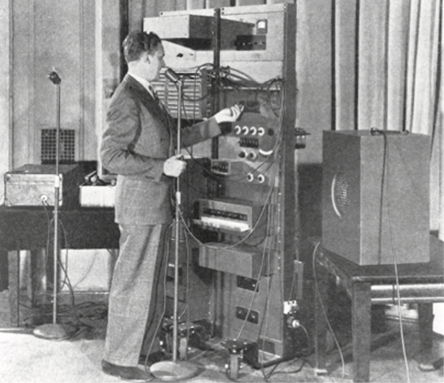Chapter Four: Synthesis

13. Speech Synthesis and the Channel Vocoder | Page 2
The Channel Vocoder: Early Electronic Speech Synthesis
The Channel Vocoder (a contraction/acronym for VOice enCODER) was developed by Homer Dudley in 1938 along with his Voder (Voice Operation DEmonstratoR) in 1939. Dudley began exploration into electronically emulating human speech physiology in 1928 while working for Bell Labs. Both devices were focused on synthetically reproducing human speech by electronically mimicking the acoustic mechanisms of the human vocal tract. He concluded that the glottis excitation source propagating into the dynamically resonating vocal tract for voiced phonemes could be analogous to a buzzy oscillator, rich in partials, routed into a dynamically controlled multiband resonant filter.

The Early Vocoder
The voder produced speech-like utterances electronically through a succession of mechanical key presses performed by trained humans, as demonstrated in this video. The channel vocoder, pictured here, however, used a front end that analyzed actual speech input and passed controlling signals to the voder resynthesis stage to recreate many aspects of that speech autonomously. Prior to the development of the phase vocoder, the device was simply called a vocoder.
Left: C. W. Vaderson with the Dudley vocoder. Courtesy of AT&T Archives and History Center.
The vocoder served several primary functions. It was first an experimental platform to explore how human speech physiology worked and how it could be emulated by electronic circuitry. Second, the manner in which it encoded speech made it ideal for reducing the bandwidth required for speech transmission. There is a high degree of data reduction between the original input signal and the control signals. This made this technology ideal for audio data compression and of great interest to telecommunications companies such as AT&T, parent of Bells Labs, and to the military. It can be considered one of the early audio compression codecs (coder/decoder), similar to modern mp3’s, and allowed for the passing of multiple simultaneous messages on a single cable pair. Vocoder technology is still employed in digital forms of modern telephony.
Third, because it passed low-bandwidth control signals which could be easily encrypted rather than passing the actual high-bandwidth audio input signal, it was used during WWII to transmit top secret military messages wirelessly and by cable that could then be decoded on the receiving end by those with matching voder technology and configuration data. These signals could be recorded, stored, sampled at slow rates and broadcast at a later time.
Finally, it could be used both musically and for entertainment by altering and modifying speech. When it became commercially available in the 1970’s, an explosion of use in commercial and electronic studio music ensued, along with adoption by many commercial music groups such as Kraftwerk. It of course became the go-to technology for Hollywood as well for any and all robot and computer speech.
The channel vocoder employed an early form of synthesis by analysis, a class of techniques still in use today. While the vocoder’s output would have many of the characteristics of the input, in its classic form, it would be missing some speech information, such as accurate pitch inflection, a full and accurate harmonic spectrum and less than ideal sibilants and plosives (unvoiced or stopped sounds, such as s’s, t’s, p’s, etc.). These compromises made it an ideal Hollywood tool for representing non-human automata such as robots, talking robot dogs and later, talking computers. As the technology developed, however, 1970’s vocoder technology proliferated in electronic studio and popular music as affordable hardware boxes made by Moog, Korg and others made it accessible to the masses. Deployed as either analog circuitry or digital signal processing, vocoder-based techniques were able to take spoken words and harmonize them through resynthesis. While the channel vocoder technique gave way to digital phase vocoding and linear predictive coding (LPC) techniques, it is still used creatively in music and is available as audio plug-ins, or easily built in music coding languages.